
Bananas
Bananas are tropical perennial plants whose fruits are used both for cooking (plantains) and as table fruits (dessert). They may also be processed into starch, chips, puree, beer (in Africa), vinegar, or may be dehydrated and sold as dried fruit. Flour is produced from both plantains and table bananas, which can then be used in soups, baking or as a drink. Bananas are easy to digest hence provide quick energy.
Banana will produce the first yield about 18 months after planting. Tissue culture bananas yield considerably higher than traditionally propagated bananas when planted in clean soil that has not been previously used for banana production in the recent past
Altitude range
Bananas require altitudes of 0-1800 masl,
Soil type and conditions
well-drained, deep, fertile, and light to medium loamy soils with high organic matter with pH of 5.5 – 6.5. Banana nutrient requirements include: N, P, K, Mg, Ca, S, B, Cu, Fe, Mn, Zn, Mo.
Temperature range
The temperatures should be 20 – 30 oC.
Rainfall
The rainfall should be 1000 – 2500 (3600) mm p.a.
Steps during land preparation
- Remove stamps and any other roots from previous vegetation
- Spacing; Dwarf varieties (3 x 3) M like Dwarf cavendish and Giant varieties like Giant cavendish, FHIA;
- Dig holes 60 cm wide x 60 cm deep to break hard pan
- In dry and semi-arid areas, dig holes measuring 90 cm x 90 cm x 60 cm
- Put topsoil (first 30 cm) on one side of the hole and sub-soil on the other side
- Mix 10-20 kg of farmyard manure or compost with the topsoil
Planting materials
- Suckers (corms, peepers, sword and maiden suckers)
- Tissue Culture (TC) plantlets are pest-and disease free
- Undertake hot water treatment for suckers before use as planting materials.
- Use Tissue culture bananas from accredited nurseries or institutions like; JKUAT, KALRO and Private certified companies.
- Tissue culture banana seedling should be at least 200-300mm high at planting and have 5 healthy dark leaves.
- Select planting material from healthy plants free of pests and diseases, from recommended sources.
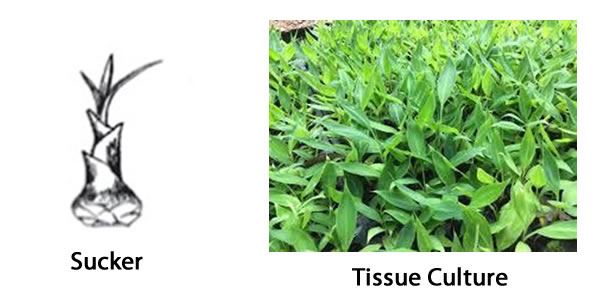
Ensure the required variety
Cooking types; (Ngombe, Nusu Ngombe, Kisii Matoke, Uganda green, Murule)
Ripening types; (Giant Cavendish, FHIA 17,18,23, Grand Naine, Poyo, Valery, Williams, Lacatan)
Dual purpose; (Nusu Ngombe, FHIA 18, Eshinamuli)
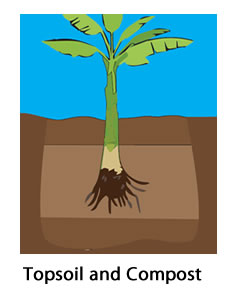
- Conduct soil test/analysis before establishing the crop
- Replenish nutrients as per recommendations of soil test/analysis results
- Add manure and fertilizers to the soil in the right amounts to provide the required plant nutrients for vigorous crop growth
- Repeat soil test/analysis after 3 years
- Change banana crop after 10-15 years and rotate with other crops like cereals to break pest and disease cycle and to avoid disease build-up
- Topsoil and compost
- Plant at the beginning of the rainy season to ensure good establishment
- Mulch around the basin, 30 to 50 cm (60 cm) away from the plant/stool, to help roots to bury deep in the ground, and help control banana weevils
- Irrigate during dry spells and in areas with long dry seasons where rainfall is less than 220 mm per month, to avoid drying up of the crop
- Mulch around the basin, 30 to 50 cm (60 cm) away from the plant/stool, to maintain moisture, help roots to bury deep in the ground, and help control banana weevils
- Intercrop with legumes such as mucuna, dolichos or cowpeas for use as green manure to help supply nitrogen and maintain soil fertility
- Weed the plant around the basin, 4-6 weeks after establishment to allow free air flow and to control pest and disease build-up
- Perform frequent shallow weeding to keep the field free of weeds
- Mulch around the basin, 30 to 50 cm (60 cm) away from the plant/stool, to; reduce weed emergence, maintain a layer of humus and enhance microbiological activity in the soil.
- Top dress with 200g DAP and 200-300g CAN per stool per year in a circle of 50-100 cm diameter, depending on soil analysis results
- Apply 5-10kg compost of farmyard manure per stool/year
- Prune or de-sucker to allow 1 flowering or fruiting stem and 2-3 suckers of different size for continuous banana production
- Support the fruit-bearing pseudo-stem with wooden or Y-sticks to prevent breakage caused by heavy bunches
- Remove the male buds after completion of finger formation
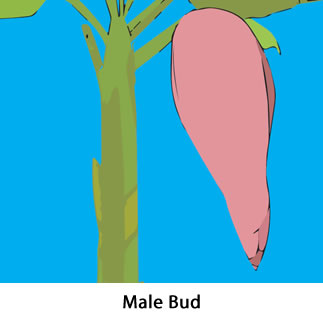
Control of nematodes
- Use resistant, clean planting material
- Rogue infested plants
- Biological control using Paecilomyces lilacinus, a fungus, which parasitizes the egg, larva and adult of the nematode
- Incorporate neem cake powder into the soil near the banana plants
- Plant few seeds of Mexican marigold to control nematodes and uproot before seeding
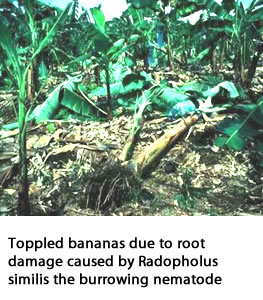
Control of weevils
- Hot water treatment (trimmed suckers are dipped in hot water (50-55oC) for 20-30 minutes
- Chop the corm and pseudostem to hasten decomposition, trapping and collection of adult weevils
- Apply 60-100 g of neem seed powder or neem cake at planting and then at 4 months intervals significantly diminished pest damage and increased yields
- Field sanitation
- Crop rotation
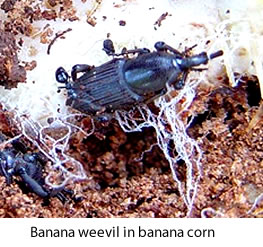
Control Banana Silvering Thrips
- Use clean planting material
- Bag the bunches
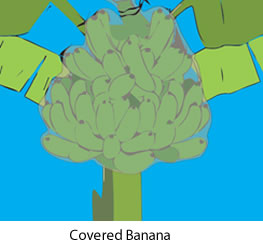
- Conserve and preserve natural enemies, such as predatory thrips, lacewings and predatory bugs
- Spot-spray with botanicals or other biopesticides. Some plant extracts (e.g. garlic, rotenone, neem, pyrethrum, and a mixture of garlic and pepper) are reported to control thrips Spinosad, a bacterial derivative, is effective in controlling thrips
- Remove the male floral parts 8-11 days after fruit formation
Aphids control
- Conserve natural enemies
- Monitor the crop regularly
- Spray with insecticides (follow IPM rules) when the levels of infestations are high
Mole control
- Use traps
- Intercrop with Tefrosia, Simsim and jack beans for controlling moles
- Use rodenticides
Bacterial Xanthomonas Wilt Control
- Use resistant varieties, if available
- Use certified disease-free planting material
- Remove male flower buds with forked stick
- Remove infected plants from fields and destroy them
- Field sanitation: Clean farm equipment using disinfectants like JIK
- Keep animals away from banana plantation
- Follow national regulations (local quarantine and restrictions, e.g. do not sell banana bunches from infected areas in BXW free areas)
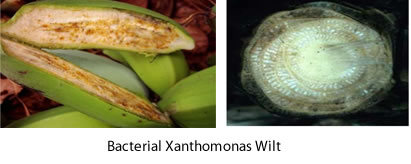
Fusarium Wilt Control
- Use of resistant varieties like Uganda green(plantain)
- Use clean planting materials
- Crop rotation
- Field sanitation
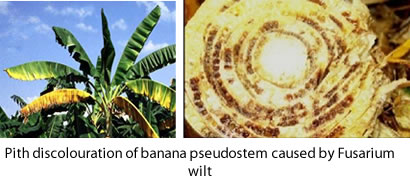
Cigar end rot Control
- Use of tolerant varieties like Grande Naine
- Field sanitation
- Remove damaged fruit and flower 8-11 days after fruit bunch emerges
- Remove the male bud 15 cm below the last hand (when the fingers have folded in)
- Bagging of mature banana stem
- Pruning and de-suckering
- Apply appropriate pesticide using IPM principles

Black sigatoka Control
- Use resistant varieties
- Remove and destroy diseases leaves
- Avoid overhead irrigation
- Avoid overcrowding of plants
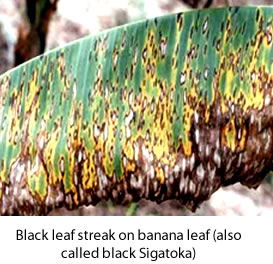
- The stage of maturity is judged by the angularity of the fingers: The more rounded a finger is in a cross-section, the more mature it is. The fingers are considered mature for harvesting when they are 3/4 round (75% maturity) and still green.
- TC bananas mature at 9-12 months while conventional suckers take 12-14 months. Some fruits turn yellow while others remain green at maturity. Maiden suckers (5-8months) takes 9-12 months to fruit. Sword suckers (about 75cm high with diameter of 15cm) takes 18 months to fruiting. Peepers suckers (young and small) takes 24 months before fruiting. The most common index of maturity is based on the fruit fingers of the banana

Cut the pseudostem at a mid-height by machete forcing it to bend under weight of the bunch. Cut the bunch without damaging it.
De-hand the bunches and deflower, wash, sort and pack the hands in carton boxes for next steps, such as transportation
- Cook bananas by boiling or steaming and eat alone or with vegetables, meat and fish
- Frying with meat, maize, beans and potato
- Ripen and eat raw as a fruit
Where they form staple food, cook by boiling or steaming and can be eaten alone or with vegetables, meat or fish, frying with meat, maize, beans and potato or ripen and eaten raw as a fruit
Bananas can also be value added (processed) to make bread, wine crisps, cakes among others
